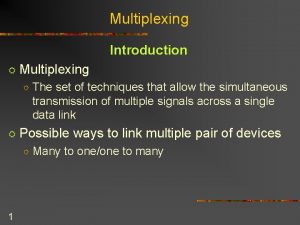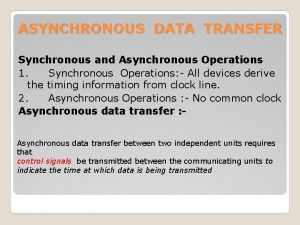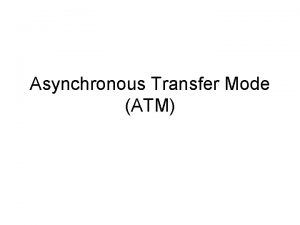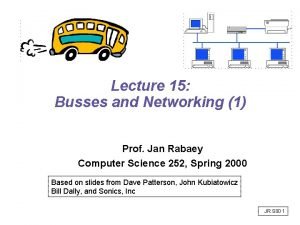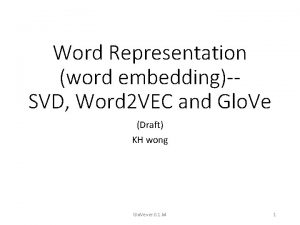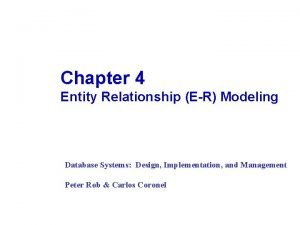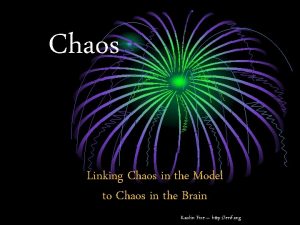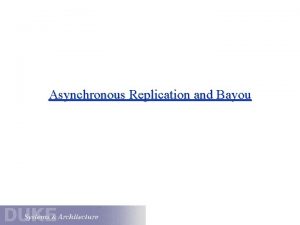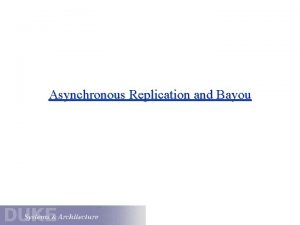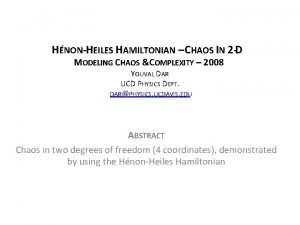Mechanism for Occurrence of Asynchronous Hyperchaos and Chaos






















- Slides: 22

Mechanism for Occurrence of Asynchronous Hyperchaos and Chaos via Blowout Bifurcations Sang-Yoon Kim Department of Physics Kangwon National University Dynamical Origin for the Occurrence of Asynchronous Hyperchaos and Chaos via Blowout Bifurcations Fully Synchronized Attractor for the Case of Strong Coupling Breakup of the Chaos Synchronization via a Blowout Bifurcation Asynchronous Hyperchaotic Attractor with Two Positive Lyapunov Exponents Asynchronous Chaotic Attractor with One Positive Lyapunov Exponent 1

Two Coupled Logistic Maps (Representative Model) N Globally Coupled 1 D Maps Reduced Map Governing the Dynamics of a Two-Cluster State Reduced 2 D Map Globally Coupled Maps with Different Coupling Weight p ( N 2/N): “coupling weight factor” corresponding to the fraction of the total population in the 2 nd cluster =0 Symmetric Coupling Case Occurrence of Asynchronous Hyperchaos =1 Unidirectional Coupling Case Occurrence of Asynchronous Chaos Investigation of the Consequence of the Blowout Bifurcation by varying from 0 to 1. 2

Transverse Stability of the Synchronous Chaotic Attractor (SCA) • Longitudinal Lyapunov Exponent of the SCA a=1. 97, s=0. 23 • Transverse Lyapunov Exponent of the SCA One-Band SCA on the Invariant Diagonal Transverse Lyapunov exponent a=1. 97 For s>s* (=0. 2299), <0 SCA on the Diagonal Occurrence of the Blowout Bifurcation for s=s* • SCA: Transversely Unstable ( >0) for s<s* • Appearance of a New Asynchronous Attractor 3

Type of Asynchronous Attractors Born via a Blowout Bifurcation New Coordinates For the accuracy of numerical calculations, we introduce new coordinates: SCA on the invariant v=0 line a=1. 97, s=0. 23 Transverse Lyapunov exponent of the SCA a=1. 97 Appearance of an Asynchronous Attractor through a Blowout Bifurcation of the SCA The Type of an Asynchronous Attractor is Determined by the Sign of its 2 nd Lyapunov Exponent 2 ( 2 > 0 Hyperchaos, 2 < 0 Chaos) [ In the system of u and v, we can follow a trajectory until its length L becomes sufficiently long (e. g. L=108) for the calculation of the Lyapunov exponents of an asynchronous attractor. ] 4

Computation of the Lyapunov Exponents 1 and 2 for a Trajectory Segment with Length L Evolution of a Set of Two Orthonormal Tangent Vectors Map Mn [ DT(zn), zn (un, vn)]. under the Linearized • Reorthonormalization by the Gram-Schmidt Reorthonormalization Method (Direction of the 1 st Vector: Unchanged) ( Has Only the Component Orthogonal to ) • 1 st and 2 nd Lyapunov Exponents 1 and 2 5

Second Lyapunov Exponent of the Asynchronous Attractor ( : =0, : =0. 852, : =1) a=1. 97, L=108 Threshold Value * ( ~ 0. 852) s. t. • < * Asynchronous Hyperchaotic Attractor (HCA) with 2 > 0 • > * Asynchronous Chaotic Attractor (CA) with 2 < 0 (dashed line: transverse Lyapunov exponent of the SCA) HCA for = 0 a = 1. 97 s = -0. 0016 1 = 0. 6087 2 = 0. 0024 CA for = 1 a = 1. 97 s = -0. 0016 1 = 0. 6157 2 = -0. 0028 6

Mechanism for the Occurrence of Asynchronous Hyperchaos and Chaos Intermittent Asynchronous Attractor Born via a Blowout Bifurcation d = |v|: Transverse Variable d*: Threshold Value s. t. d < d*: Laminar Component (Off State), d > d*: Bursting Component (On State). d (t) We numerically follow a trajectory segment with large length L (=108), and calculate its 2 nd Lyapunov exponent. Decomposition of the 2 nd Lyapunov Exponent 2 of the Asynchronous Attractor : Weighted 2 nd Lyapunov Exponent for the Laminar (Bursting) Component Fraction of the Time Spent in the i Component (Li: Time Spent in the i Component) ’ 2 nd Lyapunov Exponent of the i Component (primed summation is performed in each i component) 7

Competition between the Laminar and Bursting Components Laminar Component ( : =0, : =0. 852, : =1) a=1. 97, d*=10 -5 Bursting Component Sign of 2 : Determined via the Competition of the Laminar and Bursting Components Threshold Value * (~ 0. 852) s. t. < * > * Asynchronous Hyperchaotic Attractor with 2 > 0 Asynchronous Chaotic Attractor with 2 < 0 8

Effect of the Threshold Value d * on ( : d*=10 -6, : d*=10 -8, : d*=10 -10) • : Dependent on d * a=1. 97 As d * Decreases, a Fraction of the Old Laminar Component is Transferred to the New Bursting Component: In the limit d * 0, • 2 Depends Only on the Difference Between the Strength of the Laminar and Bursting Components. The Conclusion as to the Type of Asynchronous Attractors is Independent of d *. 9

Blowout Bifurcations in High Dimensional Invertible Systems System: Coupled Hénon Maps New Coordinates: • Type of Asynchronous Attractors Born via Blowout Bifurcations L=108 (s*=0. 787 for b=0. 1 and a=1. 83) d *=10 -4 ( : =0, : =0. 905, : =1) Threshold Value * ( 0. 905) s. t. For < * HCA with 2 > 0, for > * CA with 2 < 0. 10

HCA for = 0 a=1. 83, s=-0. 0016 1 0. 4340 2 0. 0031 CA for = 1 a=1. 83, s=-0. 0016 1 0. 4406 2 -0. 0024 System: Coupled Parametrically Forced Pendulums New Coordinates: 11

• Type of Asynchronous Attractors Born via Blowout Bifurcations (s*=0. 324 for =1. 0, =0. 5, and A=0. 85) L=107 d *=10 -4 ( : =0, : =0. 84, : =1) Threshold Value * ( 0. 84) s. t. For < * HCA with 2 > 0, for > * CA with 2 < 0. HCA for = 0 A=0. 85 s =-0. 006 1 0. 628 2 0. 017 CA for = 1 A=0. 85 s=-0. 005 1 0. 648 2 -0. 008 12

Summary Mechanism for the Occurrence of the Hyperchaos and Chaos via Blowout Bifurcations Sign of the 2 nd Lyapunov Exponent of the Asynchronous Attractor Born via a Blowout Bifurcation of the SCA: Determined via the Competition of the Laminar and Bursting Components Occurrence of the Hyperchaos Occurrence of the Chaos Similar Results: Found in High-Dimensional Invertible Period-Doubling Systems such as Coupled Hénon Maps and Coupled Parametrically Forced Pendula 13

Effect of Asynchronous UPOs on the Bursting Component Change in the Number of Asynchronous UPOs with respect to s (from the first transverse bifurcation point st to the blow-out bifurcation point s*) • Symmetric Coupling Case ( =0) (Period q=11) Type of Bifs. No. of Saddles (Ns) No. of Repellers (Nr) Transverse PFB 12 +24 0 Asyn. PDB 16 -16 +8 +16 Total No. of UPOs • Transverse PFB of a Synchronous Saddle • Asynchronous PDB 2 q q q 14

• Unidirectional Coupling Case ( =1) (Period q=11) Type of Bifs. No. of Saddles (Ns) No. of Repellers (Nr) Asyn. SNB 21 +21 Transverse TB 12 +12 -12 Asyn. PDB 9 -9 +9 +24 +18 Total No. of UPOs • Asynchronous SNB • Transverse TB • Asynchronous PDB q q q 2 q q q 15

Change in the Number of Asynchronous UPOs at the Blow-Out Bifurcation Point s* (=0. 190) with respect to (Period q=11, Ns: No. of Saddles, Nr: No. of Repellers) • SNB q • Reverse SNB Type of Bifs. No. of Bifs. Increased No. of Saddles Increased No. of Repellers SNB 13 +13 Reverse SNB 4 -4 -4 PDB 10 -10 +10 Reverse PDB 17 +17 -17 Total Increased No. of UPOs +16 +2 • PDB q 2 q q q • Reverse PDB 2 q q q 16

Transition from Chaos to Hyperchaos a=1. 83 s=0. 155 =1 1 0. 478 2 0. 018 For s = s* ( 0. 163), a Transition from Chaos to Hyperchaos Occurs. 17

Characterization of the On-Off Intermittent Attractors Born via Blow-Out Bifurcations d: Transverse Variable (Denoting the Deviation from the Diagonal) d < d *: Laminar State (Off State) d d *: Bursting State (On State) p=p*: Blow-Out Bifurcation Point • Distribution of the Laminar Length: • Scaling of the Average Bursting Amplitude: 18

Phase Diagrams in Coupled 1 D Maps System: Coupled 1 D Maps: Dissipative Coupling Case with g(x, y) = f(y) – f(x) • Periodic Synchronization Symmetric Coupling ( =0) Unidirectional Coupling ( =1) Horizontal Lines: Longitudinal Bifurcations Synchronous Period-Doubling Bifurcations, Nonhorizontal Solid and Dashed Lines: Transverse Bifurcations (Solid Lines: Period-Doubling Bifurcations. Dashed Lines for =0 and 1: Pitchfork and Transcritical Bifurcations, Respectively. ) 19

• Chaotic Synchronization Symmetric Coupling ( =0) Unidirectional Coupling ( =1) Hatched Region: Strong Synchronization, Light Gray Region: Bubbling, Dark Gray Region: Riddling Solid or Dashed Lines: First Transverse Bifurcation Lines (Solid Lines: Period-Doubling Bifurcations. Dashed Lines for =0 and 1: Pitchfork and Transcritical Bifurcations, Respectively. ) Solid Circles: Blow-Out Bifurcation 20

Inertial Coupling Case with g(x, y) = y – x • Periodic Synchronization Symmetric Coupling ( =0) Unidirectional Coupling ( =1) Horizontal Lines: Longitudinal Bifurcations Synchronous Period-Doubling Bifurcations, Nonhorizontal Solid and Dashed Lines: Transverse Bifurcations (Solid Lines: Period-Doubling Bifurcations. Dashed Lines for =0 and 1: Pitchfork and Transcritical Bifurcations, Respectively. ) 21

• Chaotic Synchronization Symmetric Coupling ( =0) Unidirectional Coupling ( =1) Hatched Region: Strong Synchronization, Light Gray Region: Bubbling, Dark Gray Region: Riddling Solid or Dashed Lines: First Transverse Bifurcation Lines (Solid Lines: Period-Doubling Bifurcations. Dashed Lines for =0 and 1: Pitchfork and Transcritical Bifurcations, Respectively. ) Solid Circles: Blow-Out Bifurcation 22
 Synchronous and asynchronous tdm
Synchronous and asynchronous tdm Difference between asynchronous and synchronous
Difference between asynchronous and synchronous Handshaking method of asynchronous data transfer
Handshaking method of asynchronous data transfer Synchronous vs asynchronous data transfer
Synchronous vs asynchronous data transfer Two i/o methods
Two i/o methods Ajax asynchronous javascript and xml
Ajax asynchronous javascript and xml What is ajax
What is ajax Asynchronous transfer mode advantages and disadvantages
Asynchronous transfer mode advantages and disadvantages Synchronous and asynchronous bus
Synchronous and asynchronous bus System bus in computer
System bus in computer Co occurrence matrix example
Co occurrence matrix example Co occurrence matrix example
Co occurrence matrix example Hide the occurrence of failure from other processes using
Hide the occurrence of failure from other processes using Gypsum occurrence
Gypsum occurrence Express action or state of being
Express action or state of being Occurrence of silicon
Occurrence of silicon Aggregate exceedance probability
Aggregate exceedance probability Entity occurrence diagram
Entity occurrence diagram Examples of irony in an occurrence at owl creek bridge
Examples of irony in an occurrence at owl creek bridge An occurrence at owl creek bridge pov
An occurrence at owl creek bridge pov Foreshadowing in owl creek bridge
Foreshadowing in owl creek bridge What is the climax of an occurrence at owl creek bridge
What is the climax of an occurrence at owl creek bridge It is an occurrence of harmony
It is an occurrence of harmony
